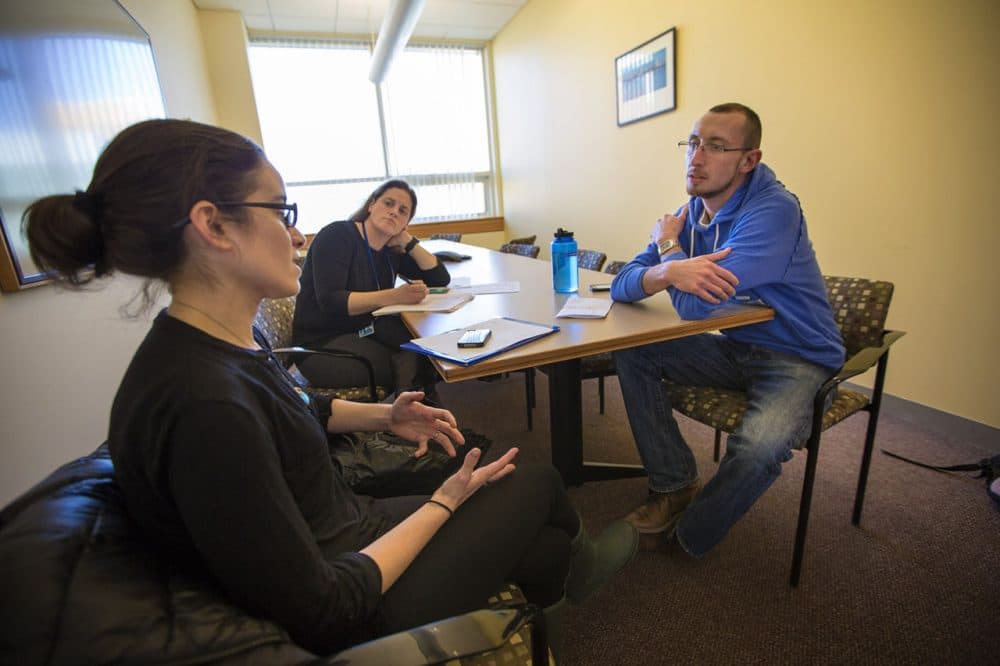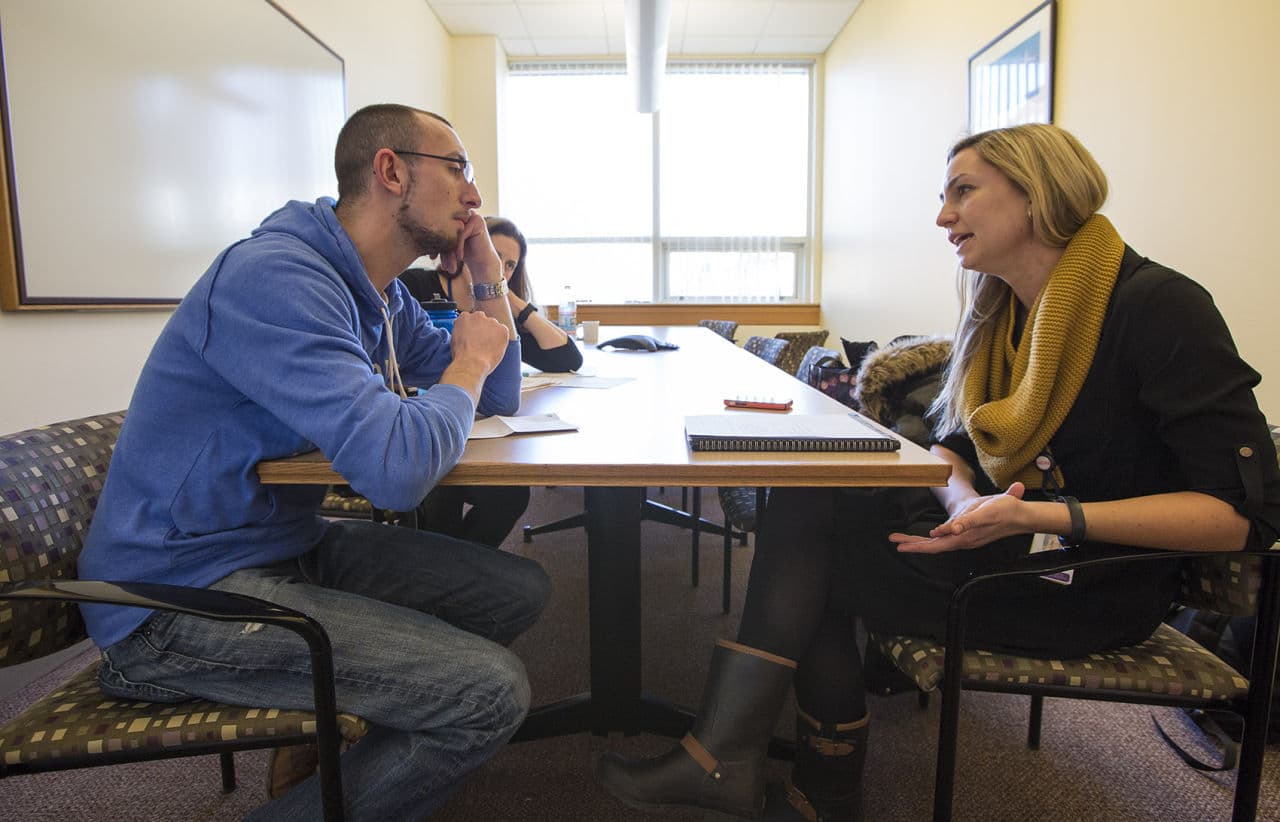Advertisement
Simmons College Course Prepares Future Social Workers To Address Suicide

In a conference room at Simmons College, two young adults sit across from each other at a table. One of them is sharing details of a very personal mental health struggle.
"I was on the inpatient unit for like a week or so," the woman says. "My parents brought me into the emergency room because I was pretty depressed and was, like, cutting myself with a scissor."
It isn't a real counseling session. It's a mid-term exam.
Laura Goodman and Justin Marotta are second-year students working toward master's degrees in social work at Simmons. They've been learning how to determine whether a client is suicidal and how to respond. They found out early in this course to come right out and ask clients whether they're thinking about suicide or have a suicide plan in place.
The mock therapy sessions allow the students to show their professors how comfortable they are having that conversation.
"So when you were cutting yourself and you were brought to inpatient, was the idea to try and kill yourself?" Marotta, acting as the social worker, asks.
"I think yeah, that time it was," Goodman, who's acting as the client, responds. "I cut a lot and I have thoughts of suicide a lot."
When the 10-minute exam is over, Marotta realizes he didn't ask his mock client about any access to guns.
"I knew the whole time. I just wanted to find an appropriate way," he tells assistant professor Kim O'Brien.
O'Brien has taught students it's crucial to ask that question, because having a gun in the home increases the risk of suicide. But she understands the conversation is nuanced and takes time. She tells Marotta he should have also asked the client about use of alcohol or drugs.
Advertisement
'There's A Lot Of Fear And Panic'
When O'Brien received her master's degree in social work (MSW), she says she didn't feel adequately trained to work with suicidal clients. She went on to receive training while working at Boston Children's Hospital. But she wasn't alone in feeling unprepared.
Surveys have found most MSW students receive four or fewer hours of instruction in suicide prevention and intervention. Most other medical and mental health professionals also don't receive advanced training.
"I would say it's a huge problem," says Joanna Almeida, who's also an assistant professor of social work at Simmons.
With a doctorate in public health and an MSW, she comes at suicide prevention from both angles.
"I knew that there wasn't a class dedicated exclusively to suicide here at Simmons, and I thought that was a gap in the curriculum," Almeida says.
She and O'Brien developed the course, "Understanding Suicide: Prevention, Intervention, and Postvention." Simmons offered it for the first time last spring. It's the first course of its kind at any Massachusetts college, and only a handful of schools around the country offer similar courses.
Almeida says students were shocked to learn the epidemiology of suicide. It kills more people than homicide or car crashes. There were more than 42,000 suicides in the United States in 2014. It's the 10th-leading cause of death overall, but the second-leading cause of death for those 10 to 34 years old, according to the Centers for Disease Control and Prevention.
Research has found lack of expertise among social work faculty is one reason there aren't more courses nationally to train clinicians in suicide prevention. Almeida believes the failure to teach it also stems from the same stigma that surrounds the issue in general. And there are ramifications.
"It means that there's a lot of referring to the emergency room because clinicians don't feel confident in their skills and ability to handle a suicide assessment," Almeida explains. "There's a lot of fear and panic that happens when they're told that they have a client who is suicidal."
The state Department of Public Health, which also sponsors courses to train clinicians in suicide prevention, notified other social work schools in the state about the Simmons course.
Simmons is sharing the curriculum with any school in the U.S. that wants to offer it. Salem State University will begin offering the class this summer. The University of New Hampshire and the University of Kentucky have adopted the class, and others have expressed interest.
'Our Goal In Our Work Should Be Zero Suicides'

In one session of the class, visiting instructor Laika Aguinaldo teaches the students specific methods of intervening to prevent suicide.
She tells the students about an experience in which she asked a suicidal client to make a visual art piece highlighting the client's reasons for living.
A student asks Aguinaldo what tipped her off that she needed to do that kind of intervention.
"My issue with this client in particular was that this is her first time disclosing the suicidality to anybody," Aguinaldo explains. "When she went to the emergency room, she said she had a panic attack. And they missed the suicidal thoughts."
Social work student Emily Wolcott says the course has helped her feel more comfortable counseling suicidal adolescents in her internship at a community health center.
But, she acknowledges, it's stressful.
"I think the challenges are really determining someone's level of safety and what level of care they need," Wolcott says. "Feeling that kind of responsibility is, like, very intense."
It's especially hard when someone doesn't readily acknowledge having suicidal thoughts.
A recurring theme throughout the course is empathy — really listening to people who are suicidal without judgment, conveying that you understand how hard things are for them, and not trying to prevent them from having the suicidal thoughts — but instead, finding a way to manage the thoughts.
"If you can bring your real self to the table, I think that's super important," student Marotta reflects. "I think that particularly in working with teens, that they can read right through you and whether you're being genuine and sincere, versus saying a script that you say to everybody."
Professor O'Brien wants the social-workers-in-training to remember suicide is preventable.
"A lot of our students come in thinking, well, it's someone's choice — if they are going to kill themselves then they are going to kill themselves, and there's nothing I can do about it," O'Brien says. "The whole thing we want them to come away from this course is saying, 'That's false.' Our goal in our work should be zero suicides. It might happen where we lose a client to suicide. I have. But that doesn't mean that it couldn't have been prevented in some way."
Surveys have found more than 90 percent of social workers encounter a suicidal client in their careers. For these soon-to-be-MSWs armed with advanced knowledge and interest in suicide prevention, that number may end up even higher.
Correction: Due to an editing error, an earlier version of this story had incorrect names in the photo captions. We regret the error.
This article was originally published on April 19, 2016.
